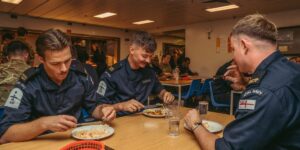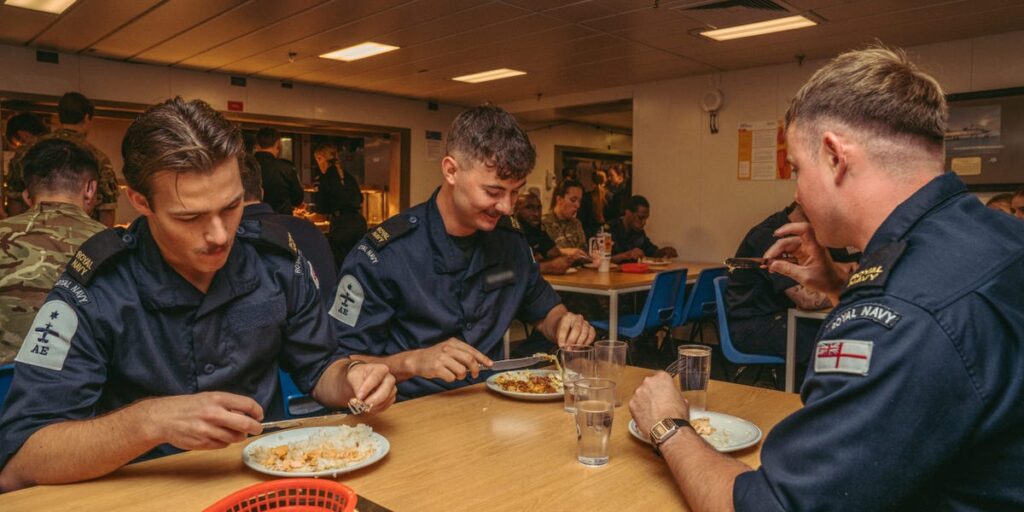Amrita Chandradas for BI
- The HMS Prince of Wales is the UK's latest aircraft carrier, with roughly 1,600 people on board.
- To feed that many people at sea, it deploys 71 catering staff who work 12-hour shifts.
- Sailors on board say the food is excellent, so I got a closer look at the kitchens.
The last time I boarded the HMS Prince of Wales, the sailors kept talking about the food.
"It's pretty good," said a Merlin HM2 operator on the captain's bridge, as I sheltered with a group of British experts from the unrelenting Singapore sun in June.
His two squadron mates, tasked with guiding us through the aircraft carrier, eagerly took us through a full list of what they eat every day.
Sailors and air wing crew regularly get steak and whole fish, and these three said they never had a complaint. During other segments of my visit, other crew members mentioned favorite meals: curries, lamb, and fish and chips.
It's rare to hear troops so readily praise the food on deployment. So when the Prince of Wales, the UK's newest aircraft carrier, returned to Singapore in late September, the Royal Navy allowed me into the 16-deck marine giant's catering facilities for a closer look.
Amrita Chandradas for BI
It was a quiet Wednesday for the kitchens as some chefs took time off in the city. The carrier strike group, halfway through an eight-month deployment in the Indo-Pacific, was departing soon. Most of the carrier's 1,600 personnel were expected to eat on board as pilots and sailors filtered in from port leave.
The deployment is a high-profile operation for the UK, which is hoping to show the region a strong front after its Queen Elizabeth-class carriers suffered repeated technical failures in recent years.
For operational security reasons, I was only cleared to view and photograph the dining and cooking areas. The RN also requested that interviewees not be identified by their last names.
Amrita Chandradas for BI
The Prince of Wales' weekly menu includes a Wednesday theme night, such as Scottish or Mexican, fish on Fridays, steak on Saturdays, and a Sunday roast dinner.
These special meals aren't specific to the Prince of Wales and are intended to be standard across the RN.
Amrita Chandradas for BI
Petty Officer Craig "Jacko," one of eight senior-ranking staff overseeing the galleys, said the carrier's kitchens have an especially strong reputation among the crew.
He cited the military adage "food is morale" as he took me through the fore galley.
Amrita Chandradas for BI
Inside, RN chefs were wrapping up lunch and starting on dinner prep. With only about two-thirds of a typical shift cooking at port, the air-conditioned galley seemed sleepier than usual.
Still, the cooks work fast and at scale. The steaming scent of salmon and roast potatoes gushed from 12 combination ovens while young chefs chopped red onions and chicken by the crateload. To haul ingredients from freezers and storerooms on other decks, chefs use twin elevators that feed into the kitchen.
"What's different here is the numbers," said Jacko, standing next to frothing vats of penne and meat sauce. "Cooking for 1,600 people, it's a lot busier. We're talking about 200 kilos of meat a day."
Amrita Chandradas for BI
Menus are the same for officers and crew, who all get breakfast, lunch, dinner, and a midnight meal. When in a heightened alert posture, the Prince of Wales offers two breakfasts — à la Lord of the Rings — with one beginning at 4:30 a.m.
On a typical day, the crew has four to five options per meal, totaling roughly 20 to 25 types of mains a day.
Lunch on the Thursday before I visited, for example, was currywurst and onions, Philly cheesesteaks, peri-peri chicken, cheese and veggie baguettes, and jacket potatoes, salads, cold meats, fruit, and a soup of the day.
The theme that night was Italian, with oven-baked lasagna, chicken parms, Roman-style roast lamb, spinach and ricotta spaghetti, Parmesan roast potatoes, and focaccia. For dessert, the crew was served tiramisu with cream on the side.
Amrita Chandradas for BI
Jacko said galley staff, thousands of miles from home, eventually plan some menus by asking around for cravings.
After five months at sea, a warrant officer said he was pining for ham, eggs, and chips — a UK staple. So, Jacko said, the Prince of Wales served it up for lunch on a Thursday.
"That was big, probably the busiest meal I've seen for a long time," he said.
Amrita Chandradas for Bi
Jacko said the Prince of Wales' food is the top in the RN because there are so many chefs on board.
The carrier has 71 catering staff to feed 1,600 people, with 15 managers and 56 junior rates responsible for cooking roughly 8,000 meals a day.
"Their secondary roles are fewer, so they can do more in the galley," he said.
Amrita Chandradas for BI
Though the carrier was only running one kitchen while docked in Singapore, it usually operates two main galleys, a 24/7 snack bar for flight crews and pilots, and a private galley for top commanders.
Before dawn, a bakery attached to the fore galley pumps out pizza dough, pie crusts, baguettes, and up to 300 loaves of fresh bread, some of which are flown by helicopter to other warships escorting the Prince of Wales.
Most galleys cook and prep nonstop, and chefs work 12-hour shifts while performing an additional duty every four days.
"It's just a constant bombardment of work," Jacko said.
Amrita Chandradas for BI
AB1 Ockeem "Hibby" is gunning for a promotion. He was put in charge of Wednesday's lunch menu, which included salmon fillets, sausages with onions, palm-sized steak bakes, and crushed potatoes that you could shower with cheese, tuna, and baked beans.
"You have to watch out for dietary requirements, that's the main thing," said Hibby, who joined the Prince of Wales' crew in December. "We have people who eat gluten-free, we have vegetarians, we have vegans."
Amrita Chandradas for BI
Jacko said the sheer number of chefs on the carrier makes it easier to diversify meals on long deployments, since every cook can add their own twist to the menu.
Hibby, of Jamaican descent, oversaw a Jamaican Independence Day dinner for the entire ship in August.
Amrita Chandradas for BI
As part of his promotion assessment, Hibby meets with senior staff to discuss kitchen assignments and the menu.
This challenge tests whether cooks are ready to think and plan in large numbers, Jacko said.
"A lot of people come straight from training, and they've gone from cooking for about 100 people to cooking for 1,000 people," he said. "They know exactly what to do and how to do it, but they need more coaching and mentoring on the numbers and quantity."
Amrita Chandradas for BI
Chefs also learn deployment-friendly recipes from navies they visit, like gyros and kebabs from Greece. As the carrier approached Singapore last week, its galleys served Hoi Sin duck breast, glazed tofu, spring rolls, and keropok, or prawn crackers.
To procure ingredients like these, the Prince of Wales resupplies when it docks, facilitated by agents stationed in port countries who work from domestic suppliers. That often means the ship buys whatever it can from the local region.
"Coming out to this side of the world, we've been able to facilitate foods like snapper, shark, kangaroo," said Lt. Dan, the ship's deputy logistics officer.
Amrita Chandradas for BI
Dan, who goes by his first name on the ship, said the carrier left the UK with frozen foods to spare but usually tops up with meats, milk, and fresh vegetables. While in Singapore, the ship received 11 trucks laden with roughly 30 days' worth of food, including 1,650 pounds of rice, he said.
To keep menus varied, the ship juggles a long list of groceries such as haggis, pork belly, chorizo, ribeye steaks, calamari, ham, and cooking wines. Not everything is available at each port, so balancing the carrier's stores requires supply and catering officers to predict far in advance which areas will run low in each world region.
Planning for the whole deployment started 14 months ago, Dan added.
"Until we get back to the Mediterranean, we probably won't get more sausages," he said.
Amrita Chandradas for BI
Sailors and air wing crew filed into the junior rates' hall, where everyone eats when the carrier runs a reduced service in port.
Crew generally choose only one meat option, but I ladled myself a salmon fillet and some of that precious sausage, along with potatoes and shredded cheese.
Amrita Chandradas for BI
The sausage, chewy and somewhat dry, was a tad too salty, but the salmon was evenly cooked, moist, flaky, and doused in a lightly sweet tomato sauce over rice and peas. While the cheese was nothing to write home about, the crushed spuds were warm and soft.
What struck me was that I'd just been fed a whole baked salmon fillet — an actual one, not a slice of dehydrated pale sponge advertised as a fillet, as one expects from a cookhouse. And this was on a day when the menu was watered down, the sailors told me.
You could certainly find better in a restaurant, but by military standards, this was fare I could look forward to every day. Nearby sailors and officers were polishing off their plates.
Amrita Chandradas for BI
Next to me, Lt. Andrew "Dickie" was tucking into his potatoes.
A training officer who's served for 21 years and deployed to Bahrain and Iraq on Duke-class frigates, he said the carrier's food beats anything else he's had at sea.
"For the quantity they have on board, the quality is unbelievable. You can tell they're all specialists, they're good at it," said Dickie, originally a senior enlisted engineer who commissioned in March 2020, at the height of the COVID-19 pandemic.
Matthew Loh/Business Insider
Though about 20% smaller than the USS Gerald R. Ford, the British warship has less than half of the American supercarrier's 4,500-odd crew and can house more amenities on board.
Space is still tight, but the Prince of Wales sports ice baths, saunas, inflatable swimming pools, a café, a golf simulator, three gyms, karaoke, and even a PC gaming suite.
Instead of 40-person berthing rooms, the ship puts junior sailors in cabins that fit eight bunks. And when not on alert, the crew gets a daily allowance of two 12-oz beers or equivalent servings of alcohol.
Amrita Chandradas for BI
Dan, the logistics officer, said the Prince of Wales has experimented with ways to conserve food, such as healthy days or meat-free days. Pushback from the crew was fierce, he recalled.
"Ultimately, with the work they do, three times a day, they just want to come in and have some food and home comfort," he said. "There's no sense trying to change that."
Read the full article here



